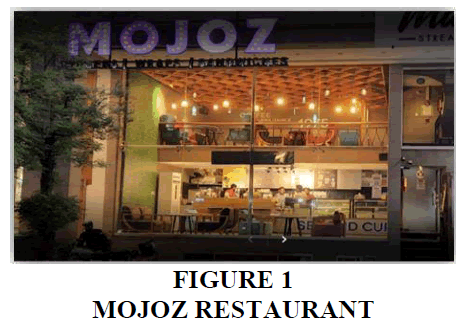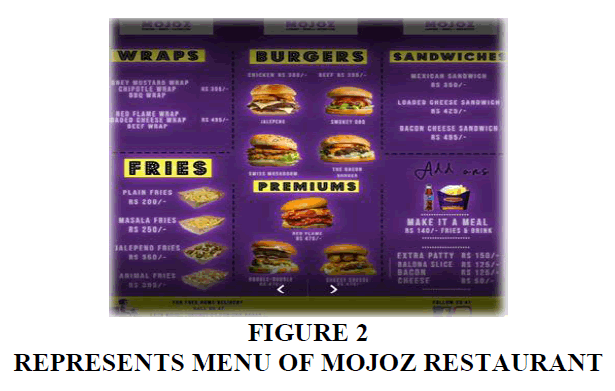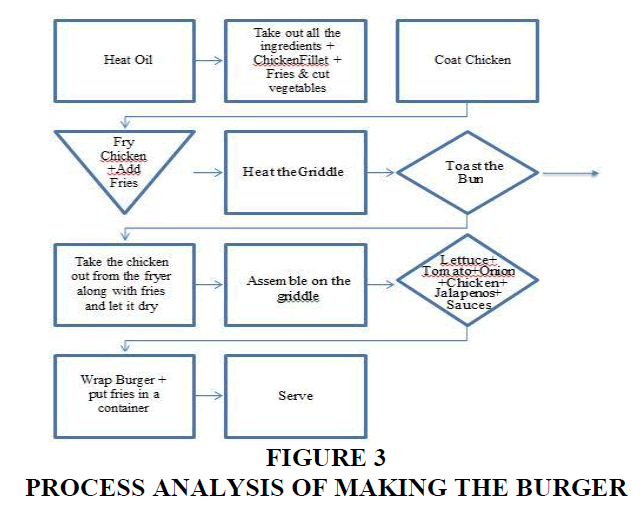Case Reports: 2023 Vol: 29 Issue: 3
Coping with Change in Emergence of Covid-19
Muhammad Zia-ud-din, Superior University
Aqsa Shafi, Superior University
Citation Information: Zia-ud-din, M. & Shafi, A. (2023). Coping with Change in Emergence of Covid-19. Journal of the International Academy for Case Studies, 29(3), 1-6.
Abstract
This case is written to examine MOJOZ restaurant, operating as BWS (burgers, wraps and sandwiches) specialist. It focusses how MOJOZ tackled with operational issues to provide excellent customer services and boost their sales during the emergence of COVID-19? Despite the fact that food business around the globe were facing variety of regulatory, health and social issues due to COVID-19 restrictions imposed by local governments, MOJOZ handled situation very well with its revised strategy to cop-up with change. The year 2020 was a challenging year for the restaurant since its launch. There were serious challenges surrounding restaurant’s growth. This case emphasis on what tools were used to manage customer relationships successfully and also highlighted marketing techniques used to create awareness about products & services offered by the restaurant. Implementation of customer relationship management system and well designed and targeted marketing campaign.
Keywords
Mojoz Restaurant, Food Preparation, Safety, Customer.
Introduction
In numerous aspects, food service industry has been fundamentally changed as it was before COVID-19, Mr. Salman (Chief Operating Officer) discussed insights about food service industry during casual discussion with group of friends. He also added, we as a society moved to a faster-paced lifestyle and similarly, our restaurants have been redefined including entire food service industry. According to Insight (2021) Food service market size till 2021 was $2323.29 and expected to grow to $5,194.60 billion by 2029 at CAGR1 of 10.76%.
Salman said that people are now more concerned about food safety and hygiene because of the risks to the general public's health, particularly in the wake of pandemic situations. Everyone wants to consume the healthiest, most hygienic meals possible because it will not harm their bodies. Nowadays, people enjoy eating outside the home as a form of entertainment. Restaurants are important for commemorating life events, enjoying cultural cuisine and much more all under one roof. By creating business models and giving millions of people jobs, restaurants indirectly support ancillary industries like farming, food, beverage and technology. For a local restaurant business owner, controlling business operations remotely had always proved to be a challenge. Dependency on a manager to run daily operations, access to accurate information in timely manner becomes challenge for the owners (Aday, S., & Aday, M.S., 2020).
Salman joined MOJOZ as a chief operating officer on 23rd May 2020 to manage overall operations of the restaurant with an opportunity to help management to make extensive changes to survive in pandemic situation. As major lockdown was imposed on 23rd March 2020 with several restrictions by local government. During the first week of joining Salman understood the marketing and customer relationship management system (CRM) gaps. It was also clear that restaurant didn’t have online order taking and home delivery facility for the customer. Team was unable to understand the importance of these value-added services in emergence of Covid-19. Restaurant was managing its supply chain very effectively. During the first month of joining Salman was fully aware the scale of challenges restaurant was facing and he had to come up with a plan to fix those issues within limited time.
Mojoz Restaurant
Mojoz’s started its operations five years ago in 2019 as the BWS (burgers, wraps and sandwiches) specialist. The restaurant opened its first outlet in DHA Lahore at prime location for fast food business. Other burger and sandwich joints like OPTP2, BOB’s3, Subway and Hardees4 are also located in the same area which Mojoz sees as their competitors. The restaurant initially started its operations with limited staff members to keep the cost low. Total numbers of employees were five, out of which two persons were looking after the kitchen; one of them was a chef, hired on the basis of expertise to bring about new variations and to improve the existing recipes (Figure 1).
Another staff member was hired to assist chef in meal preparation by following the given instructions. The manager was responsible to look after the inventory, the overall ambience of the restaurant. Another four persons are responsible for order taking and serving the meals. After starting its operations, the restaurant was flooded with orders. Due to their precise menu for all three categories (Chowdhury, M.T. et al., 2020).
MOJOZ Strength
As with all business, restaurants also have benefits from marketing in precise ways to upsurge their revenues and expand customer base. Through different channels and tools, a restaurant may develop a new marketing strategy that can help it to reach its particular goals. There is always a team behind success of any business. So, every top restaurant’s growth strategy involves customer handling and retention based that totally dependent on team. Mojoz restaurant was making a step to bring changes in the development of standards to protect and support new categories ambition. They have formed new targets and set new records across the value chain (Figure 2).
Value Proposition
The restaurant remained consistent when making their products. The number of ingredients they use does not exceed prescribed limit. The restaurant also maintains grammage of the beef patty according to the customer’s preference. The meals were served with a side of fries which were also measured in grams before serving. Restaurants have the same fresh, juicy tasting burgers every time you try it. This is because they are consistent with their entire operating procedure. Looking at other food outlets in the area with reference to pricing, MOJOZ was offering low prices as a new entrant but with higher quality. However, the competitor’s prices were expected to increase due to economic factors such as inflation. Location is most feasible for customers that are on the go and do not have much time to sit and eat in a restaurant. But MOJOZ was lacking outdoor serving staff for walking through clients. Tough, people who prefer a limited menu which enables them to quickly choose an option and be served at the earliest Mojo’s was best choice.
Standardized Food Preparation
The ingredients were marinated and prepped beforehand, when the restaurant opens in the early afternoon. Staffs prepare meat, vegetables and the sauces as per their requirement with respect to the number of orders received previously. The usual requirement was Ten kilograms of meat for chicken and beef which was purchased according to demand. The chicken fillets cleaned and marinated for two hours before use (Dekimpe, M.G., & Deleersnyder, B. 2018).
The spices were added to the minced beef and let it rest for three hours before making of round shaped patties. The vegetables were brought and cut into slices as per requirement after proper cleaning and washing. The burger buns, tortilla wraps and sandwich bread were delivered by the vendor Dawn Bread Company on daily basis. The total number of products to be ordered were calculated based on previous data. The sauces were also made by the chef who prepare these one by one as they have only one dedicated utensil to do so. Restaurant was offering three kinds of sauces: thousand island, honey mustard and chipotle, each sauce takes fifteen minutes to prepare (Figure 3).
Planned Sourcing
At Mojoz, a manager was the key individual who manages all management operations and procurement of various materials. Some items were being purchased through various vendors and some of those were being purchased themselves as per convenience. For Example, Procurement of vegetables was done on daily basis to make sure freshness and crunch while being consumed. Vegetables were bought daily from Imtiaz Supermarket that is just at walking distance from the restaurant. There were two different vendors for Chicken and beef to ensure no compromise on the quality. Fresh Chicken was supplied by vendor on daily basis and beef from any Supermarket because it’s properly packed and also meet requirement of minced beef to make patties. Every ingredient was carefully packed in a thermo pole plate and then wrapped in a cling film sheet to ensure that it is safely transported.
Significant quantity of large cans of Swiss mushrooms, pickles, jalapenos and pickles were purchased and consumed of weekly basis, along with most important ingredient named as Mozzarella cheese. These consumables were procured themselves directly from Imtiaz Supermarket5 according to the need. The main ingredient of the burger is the bun that was procured directly from the Dawn Bread Company. They deliver the buns, tortilla wraps and sandwich bread every day to make sure freshness and to meet quality standard (Hoekstra, J.C., & Leeflang, P.S. 2020).
Key Issue During Covid-19
Target Market Issue
Melis, K., et al., (2016) MOJOZ operational hours were decided to target school going children, who after school would be stopping over to just grab a quick meal. Adults would also be stopping over to meet some friends and have a meal that would be like after office hours or maybe for dinner. The gap was realized by Salman at very start of his career with MOJOZ. Because of Covid-19 people preferred home deliveries as there were restrictions imposed by the local government to avoid human interactions and sit-in at restaurants. Schools were also closed and online classes concept was introduced to control COVID-19 spread. Salman came up with a plan to introduce home delivery services to serve MOJOZ clients at their door steps. Restaurant was situated at very ideal location in surrounding of large residential areas. By introducing home delivery service overall reach was extended with increased target market. Keeping in view covid-19 restrictions people were tend to have outside food at their door steps. People who tend to have above average income would be more of a frequent user and would be having more of outside food and spending. Salman also suggested hiring two riders on commission base to provide door step services by keeping in view the fix cost issues. This idea worked very effectively and there was a significance change in sales of MOJOZ.
Customer Relationship Management System (CRM) Issues
Norris, et al (2021) Salman realized that to make repeat sales from existing customer base is very significant in generation of regular revenue inflows and to increase profitability. Attracting a new customer costs five times more as compare to retain an existing one. So, retention of repeat customers is always a cost-effective strategy for any restaurant. As with many other restaurants MOJOZ was struggling to generate repeat sales from 70% of their existing customer base. If MOJOZ were able to make single extra visit form just 20% of existing customers, Salman was calculating the impact of that on the restaurant sales and revenues. The first step to making any customer return to same restaurant is to make their first visit a great experience. While ensuring quality of food, drinks with consistency through well trained staff enables restaurant to have repeat sales.
As a chief operating officer Salman realized the importance of customer relationship management system (CRM) and implemented it successfully. Customer relationship management system helps MOJOZ to collect customer’s contact details, target one-time visitors, send post-visit thanking emails, send automated birthday wishes, offer discounts on special occasions and promote different product offerings. Implementation of CRM helped an outstanding boost in MOJOZ repeat sales and enabled to attract 50% of existing customer to have second visit. This almost doubled the revenue of the restaurant with minimal cost and without any expansion (Table 1).
| Table 1 Cpm Calculation | ||||
| Tasks | Activity Code | Predecessor Activity | Time per task (min) | Slack |
| Heat Oil | A | None | 15 | 0 |
| Take out the ingredients + all Chicken Fillet + Fries & cut vegetables | B | A | 3 | 0 |
| Coat Chicken | C | B | 2 | 0 |
| Fry Chicken + Add Fries | D | C | 5 | 0 |
| Heat the Griddle | E | D | 2.5 | 0 |
| Toast the Bun | F | E | 0.5 | 0 |
| Take the chicken out from the fryer along with fries & let it dry | G | F | 2 | 0 |
| Assemble on Griddle | H | G | 0.5 | 0 |
| Lettuce + Tomato + Onion + Jalapenos + Sauces | I | H | 0.5 | 0 |
| Wrap Burger + Put fries in the container | J | I | 0.5 | 0 |
| Serve | K | J | 0.5 | 0 |
What should management do?
There were significant difficulties surrounding Mojoz Restaurant, which have impacted the viability of expanding businesses. The introduction of the new fast-food products was not having a significant impact on sales and increase customer base. The following questions should have been replied by the management. How can changing restaurant’s marketing strategy will affect long-term business performance? What kind of marketing plan ought to be used by the management to foster a favourable perception among customers?
End Notes
1.Compounded Annual Growth Rate (CAGR).
2.OPTP – One Potato Two Potato (The Potato Factory International) one of Pakistan's most rapidly growing and largest fast food brands with their presence in 19 cities at 73 locations.
3.Bobs Burgers & Fries, Lahore, Pakistan.
4.Hardee’s: Fast food restaurant outlets in all large cities in the country having the most exotic and premium burgers availability. Insight, F.B. (2021). Food Service Market Size. Retrieved from https://www.fortunebusinessinsights.com/food-service-market-106277
5.Imtiaz Super Market (ISM), is a Pakistan’s supermarket operating with chain across the country. It’s estimated yearly turnover is PKRs 1,000 billion, a key competitor of Carrefour Pakistan and Metro Cash & Carry Pakistan.
References
Aday, S., & Aday, M.S. (2020). Impact of COVID-19 on the food supply chain. Food Quality and Safety, 4(4), 167-180.
Indexed at, Google Scholar, Cross Ref
Chowdhury, M.T., Sarkar, A., Paul, S.K., & Moktadir, M.A. (2020). A case study on strategies to deal with the impacts of COVID-19 pandemic in the food and beverage industry. Operations Management Research, 1-13.
Indexed at, Google Scholar, Cross Ref
Dekimpe, M.G., & Deleersnyder, B. (2018). Business cycle research in marketing: A review and research agenda. Journal of the Academy of Marketing Science, 46, 31-58.
Indexed at, Google Scholar, Cross Ref
Hoekstra, J.C., & Leeflang, P.S. (2020). Marketing in the era of COVID-19. Italian Journal of Marketing, 2020(4), 249-260.
Indexed at, Google Scholar, Cross Ref
Melis, K., Campo, K., Lamey, L., & Breugelmans, E. (2016). A bigger slice of the multichannel grocery pie: when does consumers’ online channel use expand retailers’ share of wallet?. Journal of Retailing, 92(3), 268-286.
Indexed at, Google Scholar, Cross Ref
Norris, C.L., Taylor Jr, S., & Taylor, D.C. (2021). Pivot! How the restaurant industry adapted during COVID-19 restrictions. International Hospitality Review, 35(2), 132-155.
Indexed at, Google Scholar, Cross Ref
Received: 26-Aug-2023, Manuscript No. jiacs-23-13937; Editor assigned: 29-Aug-2023, PreQC No. jiacs-23-13937(PQ); Reviewed: 12-Sep-2023, QC No. jiacs-23-13937; Revised: 19-Sep-2023, Manuscript No. jiacs-23-13937(R); Published: 26-Sep-2023


